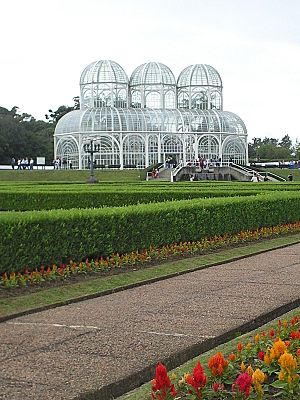Greenhouse facts for kids
A greenhouse is a special building for growing plants. It's also called a glass-house or hothouse. Greenhouses usually have a roof made of glass or clear plastic. Their walls are often made of glass or plastic too. During the day, sunlight shines through the roof and walls. This sunlight heats up the plants, soil, and the building itself. This warmth then slowly releases throughout the night, keeping the plants cozy.
Contents
Types of Greenhouses
Greenhouses come in many shapes and sizes. They also have different jobs. Some people have small greenhouses in their backyard. These are often called mini greenhouses or tomato houses. They might even be attached to a house, like a lean-to. People use these to start seeds early in the year. They also grow plants that need warmer conditions.
Larger greenhouses are used by companies. These are for growing many plants for sale. Botanic gardens also have big greenhouses. They use them to display many different kinds of plants for people to see.
Why Greenhouses Are Important
Greenhouses help us grow many vegetables and flowers. We can start them in late winter or early spring. This is when it's still too cold to plant them outside. Later, when the weather gets warmer, these plants can move outdoors.
Greenhouses are very useful in cold countries. For example, in Canada, many crops grow in greenhouses. The biggest group of greenhouses in the world is in Leamington, Ontario, Canada. Here, about 200 acres (0.8 square kilometers) of tomatoes grow in glass greenhouses!
Gardening Inside a Greenhouse
Growing plants in a greenhouse is different from growing them outside. For example, rain cannot get inside a greenhouse. So, gardeners must remember to water the plants. Greenhouses can also get very hot from the sun. Gardeners need to make sure it doesn't get too hot for the plants.
Most greenhouses have vents. These are openings that can be opened to let out extra heat. Some even have electric fans. These fans turn on automatically if the greenhouse gets too warm. Greenhouses are perfect for delicate plants. These include tomatoes, cucumbers, and eggplants.
History of Greenhouses
People have used ideas like greenhouses for a very long time. Roman gardeners grew cucumbers in special frames. These frames were covered with oiled cloth or thin sheets of mica. In the 1500s, Italian gardeners built structures. They used these to grow tropical plants brought back by explorers.
The first modern greenhouse was built in Holland by Jules Charles. In the 1800s, large greenhouses became popular in England. The idea of greenhouses also spread to the Netherlands and then England in the 17th century.
Images for kids
-
Victoria amazonica (giant Amazon waterlilies) in a large greenhouse at the Saint Petersburg Botanical Garden.
-
Cucumbers reached to the ceiling in a greenhouse in Richfield, Minnesota, where market gardeners grew a wide variety of produce for sale in Minneapolis, c. 1910
-
Versailles Orangerie at the Palace of Versailles, France.
-
A plastic air-insulated greenhouse in New Zealand
-
Giant greenhouses in Westland, the Netherlands
-
The Eden Project, in Cornwall, England
-
Greenhouses in Almería as seen from space
See also
 In Spanish: Invernadero para niños
In Spanish: Invernadero para niños

















